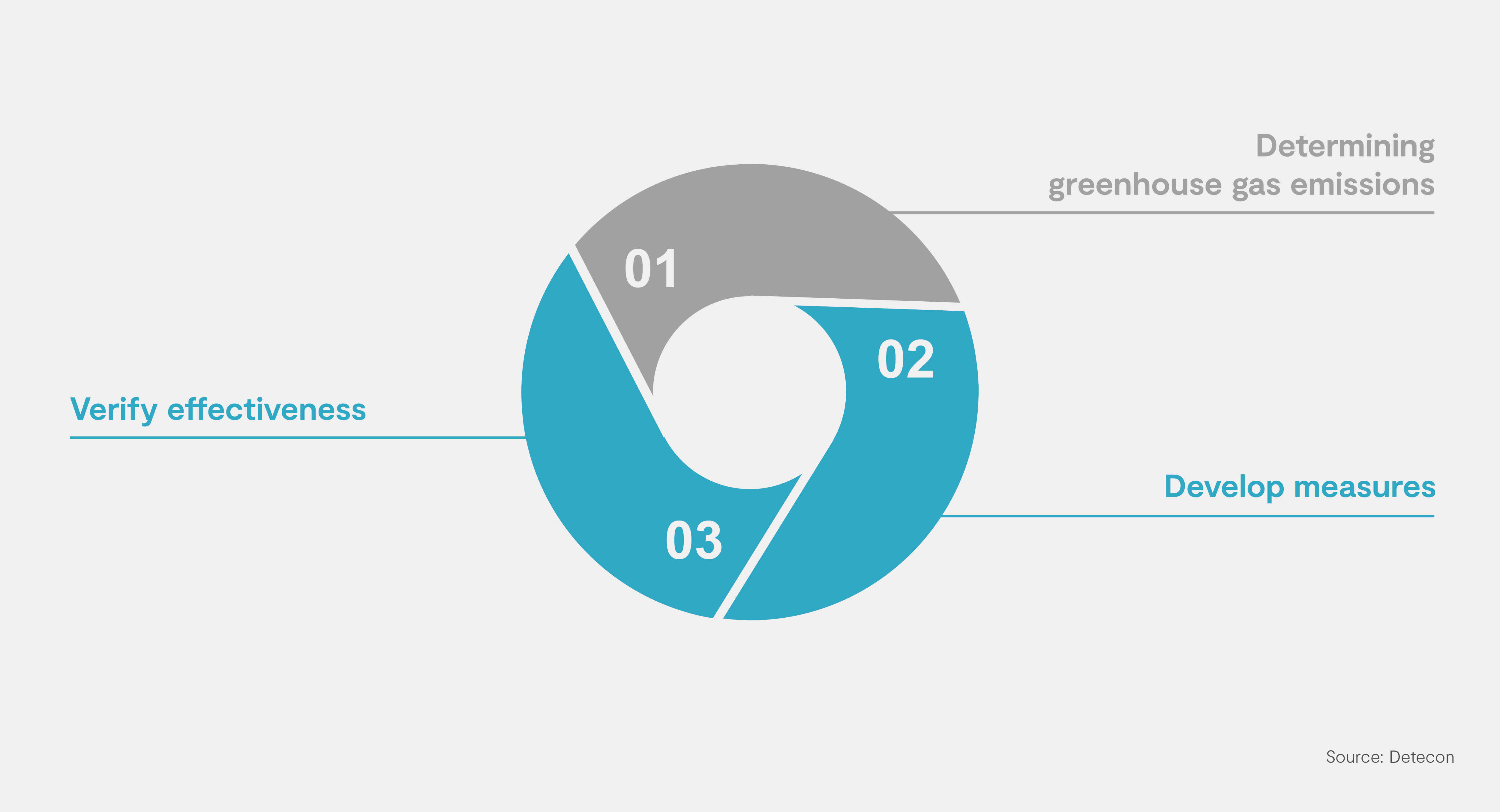The public sector needs to take significant action to achieve a carbon-neutral administration. The effectiveness of these measures is crucial: they should be regularly monitored using data. In the first article, we looked at the importance of data in achieving a climate-neutral administration and the challenges involved. In the following, we look at the implementation of the measures and how to monitor their effectiveness. (Part 2/2) Read part 1 here
A package of measures for a climate-neutral administration
The greatest possible leverage for CO2 reduction will be achieved by developing measures that focus on the core areas of IT, procurement, and organization. As stated in the coalition agreement, climate policy must be evidence-based and forward-looking. The Coordination Office for Climate-Neutral Federal Administration (Koordinierungsstelle Klimaneutrale Bundesverwaltung; KKB), which is part of the Federal Ministry for Economic Affairs and Climate Protection (Bundesministerium für Wirtschaft und Umweltschutz; BMWK), plans to publish a comprehensive program of measures for the federal administration this year, which will include specific and necessary requirements for greenhouse gas neutrality. To implement the measures, it is important to involve employees in the administration in the development of the program and, where possible, to make them actors themselves. Existing measures can be identified, and internal best practice examples highlighted. The progress and effectiveness of the measures must also be regularly reported to the relevant stakeholders - for example, a higher federal authority reports to the relevant supervisory authority (ministry).
Roadmap required to meet targets
Federal and state administrations are required to draw up a concrete roadmap of measures up to 2030, based on data and a regular review of their effectiveness. The challenges facing administrations in meeting climate change targets and increasing legal requirements will continue to grow in the coming years. According to a decision of the IT Council, new public data centers should be built exclusively in accordance with Blue Angel criteria. The recently passed Energy Efficiency Act also provides for energy efficiency measures that should lead to a total annual energy saving of 2% for federal and state administrations and other public organizations.

Plan and implement long-term actions (step 2/3)
Planning and implementing measures to reduce CO₂ emissions and achieve climate neutrality is a challenge for public administrations. Developing measures requires careful consideration of advantages and disadvantages, the involvement of staff and policymakers, and adaptation to the specific needs of the administration. Financial and human resources also play a crucial role in the implementation of climate protection measures.
Another challenge is long-term planning and effective implementation.
Example:
- A local authority's climate change manager is working with its facilities management department to install energy-saving light bulbs in buildings. The aim is to save 5% of the greenhouse gas (GHG) emissions currently caused by the property sector each year.
- The measure is not officially communicated, but employees are informed about the replacement of light sources.
- Employees and others in the buildings leave the lights on for longer or do not switch them off after work, in the belief that they are more energy efficient.
- This situation contributes to more GHG emissions and higher energy costs.
Recommendation for action - To overcome this challenge and avoid rebound effects, the following steps are recommended before introducing a measure:
- Feasibility analysis: Depending on the scope of the project, an external feasibility analysis may be useful. It considers the specific context and assesses the economic viability and feasibility of the project, as well as the expected impacts.
- Scenario analysis: Building on the feasibility analysis, a scenario analysis can provide detailed insights into the possible effects of the measures.
- Evaluation based on previous measures and comparable data: If enough data is available, the experience gained from past measures can be used to assess the effectiveness of new measures.
Before implementation, possible measures should be evaluated against criteria such as savings potential, cost/benefit, efficiency and communication impact. Economic and social aspects should also be considered.
As a first step, we recommend carrying out a feasibility and scenario analysis, using past measures and data to evaluate new measures and effectively planning and implementing the necessary measures to reduce CO₂ emissions. In addition, the necessary financial resources must be secured, e.g., by obtaining government funding, and the effectiveness of the measures must be monitored.
Best practice - a government agency as a pilot for a climate-neutral administration:
A public authority works in a climate-neutral and sustainable public administration. For several years, the authority has been working intensively on developing measures to achieve climate neutrality. To measure the success of the measures, the authority is balancing the CO2 emissions of the buildings and the vehicle fleet at its three main locations and more than 15 branch offices. The authority is running a campaign to motivate staff to adopt energy and climate-conscious behavior. At one of its main sites, this has resulted in a permanent reduction in electricity consumption of more than 10%. Ambitious building standards that lead to significant energy savings are considered in new construction measures. The authority is also systematically implementing climate protection measures at various locations in the areas of buildings, mobility, procurement, personnel, and canteen operations. Some of these measures also reduce CO2 emissions, such as giving priority to videoconferencing over business travel and using climate-friendly means of transport. Two sites have also been validated under the European Eco Management and Audit Scheme (EMAS).
Consistently reviewing effectiveness (step 3/3)
Measuring effectiveness is essential to communicate and legitimize the achievement of objectives and the success of interventions, both internally and externally. However, there are difficulties in quantifying effectiveness, particularly for 'soft' measures such as increasing employee motivation.
Example:
- An administration implements measures that can be classified as climate neutral and contribute to the reduction of greenhouse gases. They are partly the result of voluntary initiatives or cooperation with other authorities.
- However, these actions are part of a central planning or a strategy and are therefore not based on targets. Success is not controlled or monitored.
- There is a risk that the measures will continue to be implemented, but that they will not contribute to climate neutrality in the long term and may be expensive to manage.
Recommendation for action - To address these challenges, we recommend the following steps:
- Develop your own definition of effectiveness: Define what counts as “effective” in your individual case by considering and evaluating the three dimensions of ecology, economy and social issues.
- Define the scope and formulate objectives: Formulate clear objectives for each action or for specific areas. Objectives should be SMART (specific, measurable, achievable, realistic, time-bound).
- Define metrics for each objective: Define metrics against which you can measure the effectiveness of the actions. In the IT sector, for example, the Blue Angel indicators can be used for data centers or software. Also use the results of your CO₂ balance sheet as a basis.
- Check data availability: Ensure that the data required to produce the metrics is available and can be measured for the required period.
- Involve controlling: Use management controlling to develop effective measurement concepts and regularly monitor and report on the progress of the measures.
Best practice - effective target controlling based on sectoral GHG budgets
The greenhouse gas monitoring of a state capital is to be further developed into a target controlling instrument. With this project, existing budgets for achieving climate neutrality can be broken down into individual sectors and areas of action and monitored. This makes it possible to identify missed targets at an early stage. If it becomes apparent that the reduction path is not being followed, the responsible department in the state capital can initiate an adjustment of existing measures or the introduction of additional measures. In addition, the most important climate protection measures are subject to implementation monitoring and impact assessment. This allows ongoing measures to be reviewed and adjusted if necessary.
Where do I start to make my administration climate-neutral?
When deciding to implement climate protection measures or sustainability measures in general, public authorities and other administrations ask themselves where the best place to start within the organization is. The sustainability officer is a central interface for identifying initial areas of action across departments. A pilot project can be initiated together with the staff of a department. Valuable experience can be gained in terms of data availability and the development of measures that are relevant to other departments. Regular exchanges with other administrations through training and events are also helpful. Projects can be quickly identified and implemented in the areas of IT, procurement, and organization.
Developing your own data-driven definition of effectiveness, setting clear targets and key figures, reviewing data availability, and implementing effective measurement approaches are key success factors in achieving the goal of a climate-neutral administration. Effective monitoring of actions and active communication of progress to stakeholders are also important building blocks for achieving the goal.
The public sector still has a long way to go and faces many challenges in its transformation to a climate-neutral administration. The roadmap for federal administrations is to achieve net-zero greenhouse gas emissions in 7 years. Failures and lack of investment in the past need to be addressed across all administrations. Now is the time to collect data, implement measures and consistently monitor their effectiveness.








